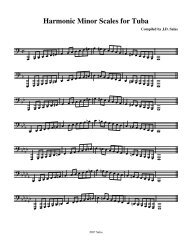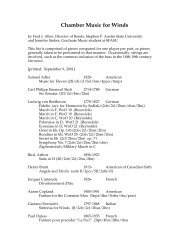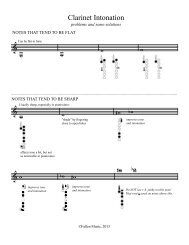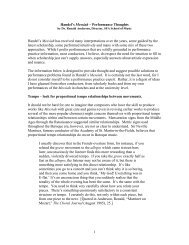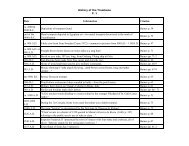Create successful ePaper yourself
Turn your PDF publications into a flip-book with our unique Google optimized e-Paper software.
<strong>Jazz</strong> <strong>Chord</strong> <strong>Symbols</strong><br />
<strong>Chord</strong> Type <strong>Symbols</strong> Used Notes Included<br />
Major Triad<br />
C<br />
Minor Triad<br />
Cm, C-, Cmi, Cmin<br />
Diminished Triad<br />
C o , Cdim<br />
Augmented Triad C + , Caug, C (#5)<br />
Minor Seventh Cm 7 , C- 7 , Cmi 7 , Cmin 7<br />
Dominant Seventh C 7<br />
Major Seventh Cmaj 7 , C∆ 7 , Cma 7 , CM 7<br />
Fully Diminished Seventh C o7 , Cdim 7<br />
Half Diminished Seventh<br />
Cm 7(b5) , C Ø7 , C- 7 (b5)
Other Bits of Useful Information:<br />
• “SLASH” CHORDS - The use of the slash in chord writing simply means that whatever is<br />
below the slash must be the bass note. Consequently, C/E indicates a C major triad with an<br />
E in the bass (first inversion). Be aware that there need not be a harmonic relationship<br />
between the chord above the slash and the note below it. This makes it possible to write<br />
chords that would be impossible to analyze in Roman numerals such as Cm/F#.<br />
• In contemporary chord symbols, there is rarely any distinction made between a diminished<br />
triad, and a fully diminished seventh chord. They are usually used interchangeably.<br />
• A special situation arises when a minor seventh chord is placed in first inversion (for<br />
example – Am7/C). While this notation will agree with traditional Roman numeral analysis,<br />
it will only rarely appear in jazz chord symbols. This type of chord would almost always be<br />
written as C 6 – that is, a C major chord, with an added 6 th scale degree.<br />
• Ninth chords follow the same conventions as seventh chords. A major ninth (C, E, G, B, D)<br />
is written Cmaj 9 , a dominant ninth (C, E, G, B b , D) is written C 9 , and a minor ninth (C, E b ,<br />
G, B b , D) is written Cm 9 .<br />
• In <strong>Jazz</strong>, most chords are voiced with four pitches (regardless of the chord) and are played in<br />
the left hand near middle C. This sometimes means leaving out pitches and sometimes<br />
means adding pitches (triads are rare in jazz). See a chord glossary pages for specifics. The<br />
right hand would either play the tune, play a solo, or emphasize roots and 5ths.<br />
• In “pop” music, there would be fewer tall chords (although Major 9 th chords are still<br />
popular) and the voicings would be more simple and played in the right hand with the left<br />
hand either not playing, or playing roots and fifths.
“Tall” <strong>Chord</strong>s<br />
Symbol Construction Notes Present<br />
C9<br />
C7+9 th<br />
Cm9<br />
Cm7+9 th<br />
Cmaj9<br />
Cmaj7+9 th<br />
C11<br />
C9+11 th but without a 3 rd<br />
(same as Gm7/C)<br />
C13<br />
C9+6 th<br />
(do NOT play an 11 th in this chord)


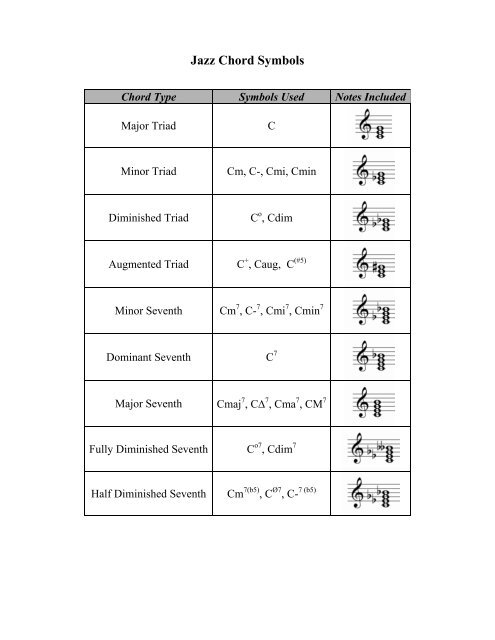
![Finale 2008 - [Whole Tone Scales - Tuba.MUS]](https://img.yumpu.com/50937649/1/190x245/finale-2008-whole-tone-scales-tubamus.jpg?quality=85)

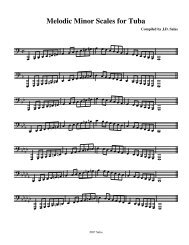
![Finale 2008 - [Chromatic Scales - Tuba.MUS]](https://img.yumpu.com/36500491/1/190x245/finale-2008-chromatic-scales-tubamus.jpg?quality=85)
